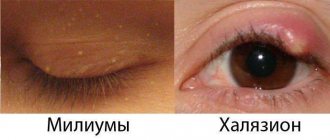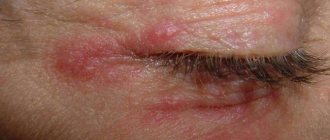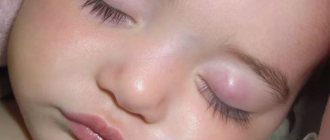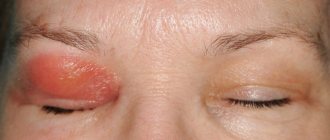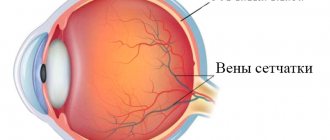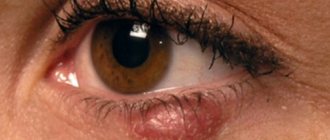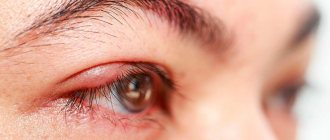When the meibomian gland, which is responsible for the moisture of the cornea, becomes inflamed, an internal stye develops on the eye. It cannot be seen immediately, since it is located in the thickness of the eyelid. But if the eyelid is slightly turned out, the inflammation will immediately become noticeable. With a strong increase, a person experiences an unpleasant painful sensation.
An abscess on the eyelid, associated with the aesthetic perception of a person’s appearance, often disrupts the usual work plans, and pain, especially with internal barley, can unsettle.
Stye is not a terrible disease that rarely causes obvious sensations of inflammation in the body, but the disease cannot be started.
General description of stye inside the eye
An internal stye has appeared on the eyelid, what is it? Stye is one of the most painful ophthalmological diseases. Occurs as a result of penetration of a bacterial infection into the mucous membrane of the eye or after irritation by dust and other small particles.
Internal stye, localized on the inside of the eyelid, has a clinical picture similar to typical stye, but these two completely different diseases should not be confused.
Internal stye or, as it is called in medicine, meibomitis, is an inflammation of the meibomian gland. The Meibomian gland is one of the sebaceous glands responsible for moisturizing the cornea. It is located in the thickness of the eyelid and is visible only when the eyelid is everted, however, as the abscess enlarges, the patient clearly feels the presence of a foreign body.
Accompanied by itching and painful sensations during blinking. A characteristic sign of the disease is a small lump, a lump, that forms on the eye a few hours after the onset of the pathological process.
The thinness of the eye tissues, in particular the eyelids, determines the painfulness of the process, which can take a long time. It must be said that internal stye on the eye, for natural reasons, most often grows slightly, so the fight against it may be shorter.
Symptoms
Visually, the picture of this disease is as follows: the patient experiences a significant increase in the size of the eyelid, severe swelling of the affected eye and redness.
A huge abscess of the upper eyelid before surgery in a young woman
In addition to the clinical picture of the disease, the following symptoms :
- the appearance of pain in the affected eyelid (the pain can be aching, throbbing or acute);
- hyperthermia, i.e. increased temperature in the source of inflammation (feeling of heat when touched) and in the whole body (temperature can rise to 37.5);
- a feeling of tension (tightness) of the skin in the affected area;
- it is possible to limit the mobility of the eyelid (severe closure of the eyelids is observed);
- decreased visual acuity of the affected eye.
Also, in addition to the listed symptoms, patients complain of general malaise, loss of appetite, drowsiness, and lethargy.
Unlike barley, the rate of pathological processes with an abscess of the eyelid is somewhat less. But, despite this, the inevitable increase in symptoms leads to a gradual increase in pain, increased hyperemia and the appearance of swelling.
An example of an abscess of the upper eyelid in a man, with the eye completely closed by a purulent sac
In some cases, symptoms of general intoxication :
- systemic hyperthermia (redness, bluish tint;
- dizziness and headache;
- decreased appetite;
- nausea and vomiting.
When the abscess spontaneously or surgically opens, a small yellowish area appears - the head. Then it increases in size due to the formation of a hole in the abscess cavity. Further, through the thinned wall of the abscess, pus flows out. Immediately after removing the pus, the temperature decreases and pain noticeably decreases.
The timing of opening the abscess may vary. Sometimes a breakthrough of pus occurs after a week, and therefore quite voluminous contents accumulate in the abscess cavity.
It is strictly forbidden to help empty an abscess by squeezing, as the infection can spread to the brain or the entire body. In this case, you cannot do without the help of a doctor (surgeon, ophthalmologist).
What types of barley are there?
I distinguish the types of styes by the location of the purulent lump in the eye on the lower or upper eyelid. It can be located on the inner or outer wall of the eyelid.
If inflammation occurs on the upper edge of the eyelid, and the lump is located outside, then an external stye develops. It's easier to detect. This type of disease is easier to treat. In the upper eyelid, internal styes are rarely diagnosed.
Internal stye in the eye occurs as a result of the onset of an inflammatory process in the meibomian gland, located close to the hair follicle. When the follicle is blocked, a pathological process begins, leading to the development of stye. Pathogenic microorganisms multiply under the eyelid, pus accumulates, and a lump forms.
Internal stye needs urgent and high-quality treatment, otherwise various complications may arise.
The main causes of barley
There is an opinion that the cause of internal barley is severe hypothermia of the body, but this is a completely wrong judgment. Hypothermia, of course, is a risk factor that directly affects the development of the inflammatory process. However, the disease can be caused by a bacterial infection or a simple skin mite.
The main causes of internal stye include:
- allergic reactions;
- hormonal changes;
- failure to comply with simple rules of personal hygiene;
- non-compliance with the rules of wearing lenses;
- weakening of the immune system;
- infections;
- hypothermia.
In fact, a weakened immune system will not be able to resist various types of infections. In this case, the eyelash bulbs, and even more so the sebaceous glands, will simply be defenseless against microbes and bacteria.
To understand exactly what caused the disease, it is recommended to go to an ophthalmologist or endocrinologist, who will not only conduct a comprehensive examination, but also help cure the problem.
Causes
The main cause of boils is bacteria. And an abscess on the eye is no exception. The infectious process develops due to the fault of staphylococcus (mainly aureus).
Having penetrated the tissue, the pathogenic microorganism provokes inflammation of the hair follicle of the eyelash or sebaceous gland.
The abscess can be located not only on the eyelash line, but also under the eye, on the eyelid, on the eyebrow.
There are a number of other reasons that contribute to the appearance of a boil on the eye:
- weak immunity is one of the main factors that increases the risk of boils. With a decrease in protective forces, the body is not able to resist the action of pathogenic and opportunistic microflora;
- diabetes mellitus and other metabolic disorders;
- relapses of infectious diseases;
- gastrointestinal problems;
- allergic reactions to various external irritations;
- consequences of the life activity of the demodex mite, which lives in the mouths of hair follicles and in the ducts of the sebaceous glands;
- blepharitis – various types of inflammatory processes of the eyelids, often of an infectious nature;
- neglect of basic hygiene rules;
- skin damage in the eye area;
- use of low-quality cosmetics;
- hypothermia of the body;
- deficiency of essential minerals and vitamins;
- stressful situations.
Symptoms of internal stye
The internal abscess appears suddenly and is not visible on the surface of the eyelid. Sometimes the disease can be expressed in some swelling. However, it can only be detected by turning out the eyelid. The disease is characterized by severe pain and discomfort.
Other symptoms include the following: the appearance of swelling around the eye; acute pain in the orbit; increased body temperature; formation of purulent infiltrate; a burning sensation, pain and itching in the area of the upper or lower eyelid.
Such symptoms can last several days until the peak of the development of the pathological process, after which the barley either opens inside, or the suppuration decreases, but the inflammation becomes chronic. In order to quickly eliminate the signs of the disease and get rid of it, it is necessary to accurately determine the causes of meibomitis.
Causes of the disease
The main cause of suppuration is the proliferation of pathogenic microorganisms, mainly staphylococci and streptococci. A purulent abscess can occur after an insect bite, when a foreign body enters the upper tissues of the eyelids, or when blackheads, comedones and other purulent and fatty growths on the skin of the eyelids are independently squeezed out.
Photo of an abscess of the upper eyelid in the stage of suppuration in an African-American man
A purulent abscess of both the upper and lower eyelids can occur with equal frequency. Also, the development of an infectious disease can lead to an abscess of the eye.
In most cases, the cause of this disease is the introduction of pathogenic bacteria (staphylococci, streptococci, etc.) onto a damaged surface of the skin or mucous membrane, for example, with a dirty hand or an untreated instrument.
Another possible cause may be purulent processes in neighboring tissues or organs (for example, styes of the eye, inflammation of the sinuses, diseases of the oral cavity).
Treatment of internal stye
The opinion that internal stye will go away on its own is wrong. The disease goes away on its own in rare cases; all this time the person will feel severe pain. If the symptoms are pronounced and the lump impairs vision, consultation and assistance from an ophthalmologist is necessary, as the disease will recur periodically.
First aid for stye is local warming with dry heat and the use of eye drops. Further treatment includes the following methods:
- taking antibacterial medications;
- physiotherapeutic procedures to relieve inflammation;
- taking vitamin supplements;
- for fever and headaches, taking antibiotics;
- in rare cases, surgery may be necessary.
Treatment at home involves using different medications: ointments and drops. The ointments are applied with clean fingers to the affected surface. You can use a cotton swab. This type of medicine is best used before bedtime as it impairs vision. During the day, the inflamed area is instilled with drops.
To avoid the development of infection, you can use drops and ointments for a healthy eye. It is also advisable to do all treatment procedures for both eyes.
Treatment of barley in the initial stage
When the disease is still at an early stage, treatment will consist of the following:
- Dry heat. A blue or UHF lamp is well suited for these purposes. The use of compresses and lotions is not recommended. Because myceration of the skin may develop. As a result, the infection will spread to the surrounding tissues.
- Alcohol and brilliant green for lubricating the skin. You can repeat this procedure three times a day.
- Instillation of “Floxal”, “Levomycetin”, “Tsiprolet”, “Dexamtazone” into the eyes. These are all eye drops that kill the infection. Various antibacterial ointments are suitable for these purposes. Doctors often prescribe Tetracycline, Hydrocortisone, and Floxal ointment. In addition to antibacterial, these agents have an anti-inflammatory effect. Sometimes they use combination drugs (“Tobradex” in the form of ointments and drops).
Help with traditional methods
Traditional medicine has a number of effective recipes for treating stye on the inner eyelid. They cannot fully replace traditional therapy, but they have a supportive effect and can speed up recovery. The most effective way to combat the disease is in a comprehensive manner: combining traditional and traditional medicine.
Help relieve pain and itching:
- warm compress of chamomile tea - warming procedures can only be carried out if the first symptoms are present, before a purulent lump has formed; after the compress, you can use ointment;
- rinsing with sage infusion - you can use a pipette for rinsing; 20 drops of infusion are dropped into each eye; Washing should be done twice a day before using the main medicine;
- warming with dry heat before a lump appears in the eye - for this use salt heated in a frying pan or a boiled egg; Warm compresses should be applied for 30 minutes until a lump appears;
- lotions from a decoction of calendula, burdock and chamomile should be done at the first symptoms;
- Along with local therapy, it is additionally recommended to take immunostimulating drinks: rosehip tea is rich in vitamin C, activates the body's defenses, and helps resist diseases.
Before using folk remedies, you must make sure that you are not allergic to the herbs and other components used. If an abscess has appeared on the lower eyelid or a lump is already beginning to form, any warming and wet lotions are contraindicated. It is better to discuss treatment with traditional methods with your doctor.
Traditional medicine recipes
Folk remedies with effective recipes:
- Warming up. This method is effective only for the initial manifestations of the disease. Boil potatoes or chicken eggs. Wrap in a scarf to avoid burning your eyes. Keep the bag on your eyelid until the potato or egg has cooled completely. Remember that heating is strictly contraindicated when a purulent core has formed, since the wound may burst and pus will flow out under the eyelid.
- Flax seed compress. Warm up the flax seeds and put them in a bag. Apply to the sore eyelid 2 times a day.
- Aloe therapy. Grind one medium-sized aloe leaf, fill it with boiling water for about 2/3, leave to brew for 10 hours. The resulting mixture should be applied to the affected area of the eye 3 times a day. The paste should be washed off 10 minutes after application.
- Plantain compress. Wash several leaves of young plantain and grind them to a liquid mass. Pour the resulting mixture with one glass of boiling water and leave to steep for 1 hour. Moisten a piece of bandage or a cotton pad and apply to the inflamed area for 10-15 minutes. Repeat the procedure at least 5 times a day.
- Washing with decoctions of medicinal plants. Take birch buds, bird cherry flowers, chamomile, and marsh rosemary. Mix the plants and pour boiling water over them. After 30 minutes, express the liquid and rinse your eyelid with it every 2-3 hours. After the abscess begins to disappear, reduce the number of washes to 5 times a day.
- Compress of calendula flowers. This plant is famous for its anti-inflammatory effect. Pour boiling water over one tablespoon of calendula inflorescences. Leave the infusion for 1 hour to infuse. After this, moisten a cotton pad and apply it to the wound for 10 minutes. This compress should be done 5 times a day. This remedy for treating an abscess does not damage the mucous membrane of the eyelid.
Remember that self-medication can lead to unpredictable consequences. If you notice strange symptoms, be sure to consult an ophthalmologist.
Fighting relapses
When barley comes out frequently, it is necessary to be examined by several specialists: an immunologist, an endocrinologist, a gastroenterologist. This will allow us to determine the degree of resistance of the pathogen to prescribed medications. Undergo a comprehensive examination to find the cause of the weakening of the body. Get tested for sugar levels in your urine and blood.
In addition, a course of autohemotherapy may be prescribed. Brewer's yeast is a good way to boost immunity.
Stye inside the lower eyelid, for which conservative treatment is powerless, can be subjected to a small surgical procedure in which the pus will be squeezed out of the meibomite. This mini operation takes place on an outpatient basis under local anesthesia. After the operation, the patient can go home.
Another method of combating relapses is flushing the meibomian gland through a special cannula. During treatment, it is recommended to wear a bandage to protect the inflamed eyelid from infection.
Is it true that internal stye on the eye is especially dangerous?
If you do not treat in a timely manner or use inappropriate methods, you may soon need surgical treatment. Complications may arise in the event of self-medication, opening an abscess, or non-compliance with treatment recommendations.
With internal barley, the following complications are possible: development of conjunctivitis; the appearance of chalazions; inflammation of the orbit; meningitis; phlegmon of the orbit; subcutaneous ball requiring surgical intervention; the development of several styes merging into a single abscess.
If the disease is advanced, it can lead to serious results. It happens that if you consult a doctor too late, the stye cannot be treated, which leads to death. If you consult an ophthalmologist at the beginning of the disease or when the disease is not too advanced, treatment will be prescribed, and therefore your health will improve.
Prevention of meibomitis
To protect yourself from stye, you need to periodically visit an ophthalmologist and promptly treat eye diseases. It’s easier to prevent a disease so you don’t have to fight it.
The main rule for the prevention of any inflammatory disease is good hygiene. Do not neglect the cleanliness of your eyes. You should only touch the mucous membranes of the eye with clean hands. So, if you need to scratch your eye, you should wash your hands first.
In windy weather, it is advisable to protect your eyes from foreign bodies getting into them. Sunglasses will help with this. They will also help protect your eyes from getting cold and dry.
Increase the body's defenses in the fight against infection. Sports and healthy eating are the main components of strengthening the immune system. If necessary, you can additionally take multivitamin complexes.
